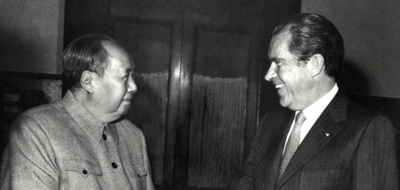Analogies, Sigmund Freud once wrote, decide nothing, but they can make one feel more at home. President Obama is explicitly comparing his diplomatic triumph with Iran to President Nixon’s opening to China in 1972. Nixon, the president explained in a July 14 interview with New York Times columnist Thomas Friedman, “understood there was the prospect, the possibility, that China could take a different path” of “very important strategic benefit to the United States” — a point repeated in supportive commentary by Fareed Zakaria, and others. Meanwhile, former Obama National Security Council official Phil Gordon has cast the president’s breakthrough with Iran as a noble contrast to the George W. Bush administration’s alleged rejection of diplomacy with North Korea, claiming that Pyongyang developed nuclear weapons because Bush refused to implement a similar disarmament framework with North Korea negotiated by President Bill Clinton.
It is not surprising that an administration that came into office rejecting geopolitics and poo-pooing strategy in favor of “don’t do stupid [stuff]” would treat history as a plaything for twitter-sized talking points. But the historical analogies most popular with the administration reveal precisely why this deal is so fraught with risk. 
Nixon was right to play the China card against the Soviets in 1971 — but for reasons that simply do not apply to Iran. First, in 1971, China already had nuclear weapons and Nixon never asked Mao to abandon them. Second, the Soviet threat to Washington and Beijing, which ultimately drove the two countries together, was incalculably graver than the threat posed by the Islamic State to either Iran or the United States (the president and National Security Adviser Susan Rice have dismissed the Islamic State as “the JV team” and “not an existential threat” so perhaps they do not even really believe their own Nixon analogies). Third, the more militant, pro-Soviet faction in China led by Lin Biao had been purged by 1971, whereas Iran’s Revolutionary Guard Corps and its Quds Force are on the ascendance and, in fact, will gain billions of dollars as a result of being delisted from the sanctions list. Fourth, by 1971 China no longer posed an existential threat to major U.S. allies in Asia (Japan, though initially shocked by Nixon’s surprise opening, rushed to normalize relations with Beijing), whereas Iran does pose an existential threat to Israel and our Gulf allies, who are more likely to hedge against lost U.S. credibility than normalize with an irredentist and threatening Iran. Taiwan was the biggest strategic loser and continued cross-Strait flare-ups demonstrate that Nixon’s opening to China was not risk-free. On the whole, however, Nixon’s bold move had a strong geostrategic rationale that is almost entirely missing from Obama’s Iran policy.
The use of the 1994 Agreed Framework as a positive example of diplomacy with a nuclearizing outcast state is not a good one for supporters of the Iran deal. First of all, the Bush administration did not come into office rejecting Clinton’s Agreed Framework with Pyongyang, as Gordon alleges. There was enormous doubt about the deal — for good reasons — but in June 2001 the Bush White House announced that it would continue implementing the nuclear deal as long as North Korea did and sent a delegation to Pyongyang in October 2002 to broaden the agenda to include issues of human rights, destabilizing regional behavior, and missiles — issues ignored by Clinton’s Agreed Framework with the North and unwisely undermined by Obama’s current agreement with Iran. What scuttled the Agreed Framework was the intelligence community’s unanimous agreement in 2002 — and Pyongyang’s subsequent acknowledgment — that North Korea had been cheating on the Agreed Framework almost from the beginning by opening a clandestine path to nuclear weapons production through uranium enrichment. The North’s most senior defector, Hwang Jang-yop, told the White House in October 2003 that he had participated directly in top-level meetings in which the lead negotiator on the Agreed Framework explained the regime’s strategy would be to prevaricate on inspections of nuclear facilities for 5 to 10 years and then “confront the Americans with an even more powerful deterrent.” And so they did — a red flag when one considers the opportunities Iran will have to confound inspectors while continuing nuclear enrichment and missile activities under the current deal.
There may be good arguments for diplomatic engagement with Tehran, but the administration’s historical analogies only make the case for opposition to the agreement struck with Iran on July 14.

